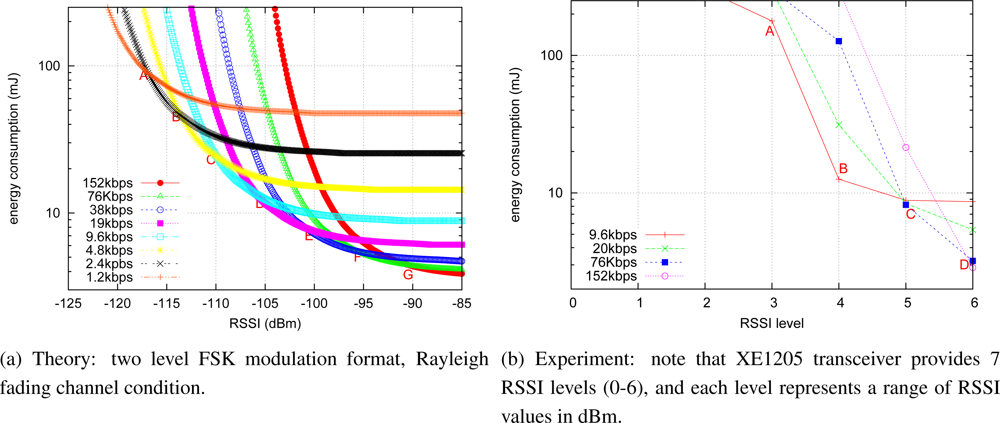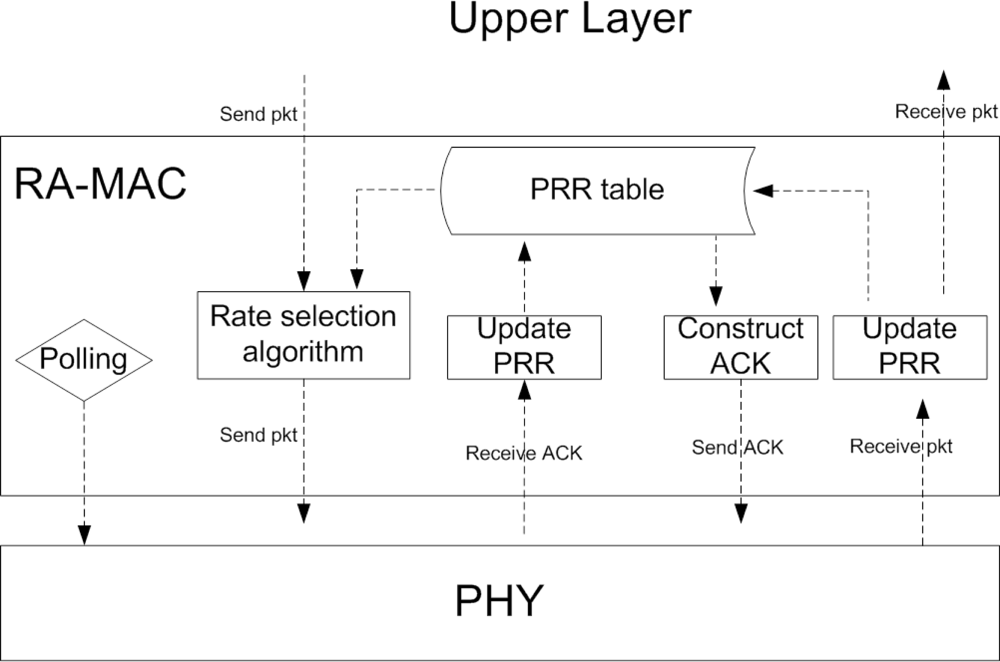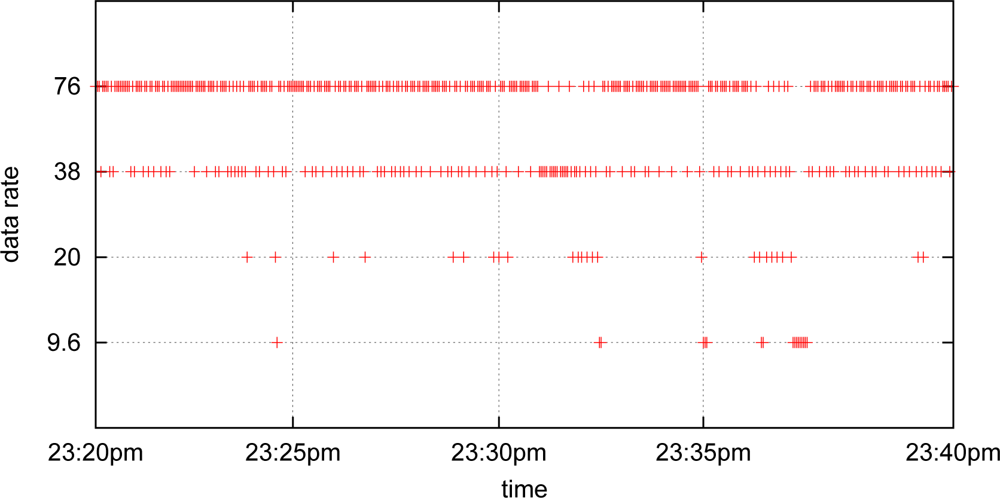An Energy-efficient Rate Adaptive Media Access Protocol (RA-MAC) for Long-lived Sensor Networks
Abstract
:1. Introduction
- RA-MAC, which is, to the best of our knowledge, the first rate-adaptive Media Access Protocol for WSNs with the purpose of minimizing network energy consumption. In contrast to conventional Wireless Local Area Networks (WLANs), where optimizing link throughput is the main focus, node energy consumption is typically a more important performance metric in WSNs. Further, rate-adaptive protocols in WLANs are typically deeply coupled with 802.11 Request To Send (RTS) and Clear to Send (CTS) message exchanges, but the packets are typically too small in WSNs to justify the RTS/CTS exchanges (e.g., the default MAC payload size is 28 bytes in TinyOS 2.x). Moreover, WLAN MAC typically do not take the cost of acknowledgement packets into account because the sizes of the data packets are significantly larger than the acknowledgement packets.
- An analytical model of the energy consumption under different channel conditions, which we use to optimize the overall network energy consumption.
2. Related Work
2.1. Medium Access Control Protocol in WSNs
2.2. Rate Adaptive MAC in Wireless Local Area Networks (802.11)
2.3. Summary
3. Packet Reception Rate
4. Energy Consumption Analysis
5. Rate Adaptive MAC (RA-MAC)
| 1: | procedure Transmit(Packet) |
| 2: | if Last transmission acknowledged then |
| 3: | S ⇐ S + 1 |
| 4: | Estimate : |
| 5: | Calculate E( , R) using Equation (11) for different R |
| 6: | |
| 7: | if S > M then |
| 8: | R ⇐ R + 1 |
| 9: | S ⇐ 0 |
| 10: | end if |
| 11: | else |
| 12: | R ⇐ R − 1 |
| 13: | S ⇐ 0 |
| 14: | end if |
| 15: | Transmit packet at data rate R |
| 16: | end procedure |
| 1: | procedure ReceiveData(Packet) |
| 2: | Collect RSSI and R |
| 3: | Calculate CRC |
| 4: | Stat ⇐ (CRC correct) ? 1:0 |
| 5: | PRRdata(RSSI, R) ⇐ (1 − β2) · PRRdata(RSSI, R) + β2 · Stat |
| 6: | if CRC correct then |
| 7: | Transmit ACK packet with RSSI and PRRdata(RSSI, R) |
| 8: | end if |
| 9: | end procedure |
| 1: | procedure WaitForAck( , R) |
| 2: | |
| 3: | t0 ⇐ tnow |
| 4: | while tnow < t0 + T do |
| 5: | if ACK received then |
| 6: | Stat = 1 |
| 7: | RSSI, PRRdata ⇐ from ACK packet |
| 8: | end if |
| 9: | end while |
| 10: | if ACK not received then |
| 11: | Stat = 0 |
| 12: | end if |
| 13: | PRRdata&ack (RSSI, R) ⇐ (1 − β3) · PRRdata&ack (RSSI, R) + β3 · succ |
| 14: | PRRack(RSSI, R) ⇐ PRRdata&ack(RSSI, R)/PRRdata(RSSI, R) |
| 15: | RSSIprev ⇐ RSSI |
| 16: | end procedure |
6. Implementation and Evaluation
6.1. TinyNode and Multi-rate Radio
6.2. TinyOS Implementation
6.3. Goals, Metrics and Methodology
- Packet delivery ratio: packet delivery ratio is calculated as the number of packets received by the receiver divided by the number of packets sent by the sender. This metric characterizes the percentage of successful source data packet delivery; ideally, this should be 100%.
- Network energy consumption: this metric characterizes the network’s energy consumption at any given instant of time. We calculate the node’s energy consumption by logging the different (transmitting, listening, sleeping) states together with time stamps. The energy consumption of a radio state is calculated as a function of power consumption level (listed in Table 1) multiplied by the duration of the state. The energy consumption of a node is the summation of the energy consumption of all three states. Ideally, the energy consumption should be as low as possible.
- Energy consumption per received packet: this metric is calculated as a function of network energy consumption divided by the number of packets successfully received by the receiver. This metric characterizes the energy cost of successfully packet delivery. Ideally, energy consumption per received packet should be as low as possible. For ease of comparison, we normalize the energy consumption per received packet of different strategies with respect to RA-MAC. Therefore, if a normalized value is larger than 1, the corresponding strategy consumes more energy, when compared to RA-MAC, in delivering one packet from source to destination.
6.4. The Impact of Traffic Load on Network Energy Consumption
6.5. Single Hop Experiment–High Traffic Load
6.6. Single Hop Experiment (Low Traffic Load)
6.7. Multi-hop Experiment
7. Comparison with WLAN Rate-adaptive MAC by Simulations
8. Conclusion
References
- Langendoen, K.; Baggio, A.; Visser, O. Murphy Loves Potatoes: Experiences from a Pilot Sensor Network Deployment in Precision Agriculture. Proceeding of the 14th International Workshop on Parallel and Distributed Real-Time Systems (WPDRTS), Rhodes, Greece; 2006. [Google Scholar]
- Selavo, L.; Wood, A.; Cao, Q.; Sookoor, T.; Liu, H.; Srinivasan, A.; Wu, Y.; Kang, W.; Stankovic, J.; Young, D.; Porter, J. LUSTER:Wireless Sensor Network for Environmental Research. Proceedings of the 5th International Conference on Embedded Networked Sensor Systems (Sensys ’07), Sydney, Australia; 2007; pp. 103–116. [Google Scholar]
- Dinh, T.L.; Hu, W.; Sikka, P.; Corke, P.; Overs, L.; Brosnan, S. Design and Deployment of a Remote Robust Sensor Network: Experiences from an Outdoor Water Quality Monitoring Network. Proceedings of Second IEEE Workshop on Practical Issues in Building Sensor Network Applications (SenseApp), Dublin, Ireland; 2007; pp. 799–806. [Google Scholar]
- Chen, Q.; Hu, W.; Corke, P. Poster Abstract: Energy-efficient Rate Adaptive MAC Protocol (RA-MAC) for Long-lived Sensor Networks. Proceedings of 6th European Conference on Wireless Sensor Networks (EWSN 09), Cork, Ireland; 2009. [Google Scholar]
- Anastasi, G.; Borgia, E.; Conti, M.; Gregori, E.; Passarella, A. Understanding the Real Behavior of 802.11 and Mote Ad hoc Networks. Pervasive Mob. Comput 2005, 1, 237–256. [Google Scholar]
- Zamalloa, M.; Krishnamachari, B. An Analysis of Unreliability and Asymmetry in Low-power Wireless Links. ACM Trans. Sens. Netw 2007, 3, 7. [Google Scholar]
- Zhao, J.; Govindan, R. Understanding Packet Delivery Performance in Dense Wireless Sensor Networks. Proceedings of the 1st International Conference on Embedded Networked Sensor Systems, Los Angeles, CA, USA; 2003; pp. 1–13. [Google Scholar]
- TinyOS. Available online: http://www.tinyos.net/ (accessed on 1 October 2009).
- Dubois-Ferrière, H.; Fabre, L.; Meier, R.; Metrailler, P. TinyNode: A Comprehensive Platform for Wireless Sensor Network Applications. Proceedings of the Fifth International Conference on Information Processing in Sensor Networks (IPSN ’06), Nashville, TN, USA; 2006; pp. 358–365. [Google Scholar]
- Ye, W.; Silva, F.; Heidemann, J. Ultra-low Duty Cycle MAC with Scheduled Channel Polling. Proceedings of the 4th International Conference on Embedded Networked Sensor Systems (SenSys ’06), Boulder, CO, USA; 2006; pp. 321–334. [Google Scholar]
- Ye, W.; Heidemann, J.; Estrin, D. An Energy-efficient MAC Protocol for Wireless Sensor Networks. Proceedings of 21st Conference of the IEEE Computer and Communications Societies (INFOCOM), New York, NY, USA; 2002; 3, pp. 1567–1576. [Google Scholar]
- van Dam, T.; Langendoen, K. An Adaptive Energy-efficient MAC Protocol for Wireless Sensor Networks. Proceedings of the 1st International Conference on Embedded Networked Sensor Systems (SenSys ’03), Los Angeles, CA, USA; 2003; pp. 171–180. [Google Scholar]
- Hill, J.; Culler, D. Mica: A Wireless Platform for Deeply Embedded Networks. IEEE Micro 2002, 22, 12–24. [Google Scholar]
- Polastre, J.; Hill, J.; Culler, D. Versatile Low Power Media Access for Wireless Sensor Networks. Proceedings of the 2nd International Conference on Embedded Networked Sensor Systems (SenSys ’04), Baltimore, MD, USA; 2004; pp. 95–107. [Google Scholar]
- Buettner, M.; Yee, G.V.; Anderson, E.; Han, R. X-MAC: A Short Preamble MAC Protocol for Duty-cycled Wireless Sensor Networks. Proceedings of the 4th International Conference on Embedded Networked Sensor Systems (SenSys ’06), Boulder, CO, USA; 2006; pp. 307–320. [Google Scholar]
- Barroso, A.; Roedig, U.; Sreenan, C.J. f-MAC: A Deterministic Media Access Control Protocol Without Time Synchronization. Proceedings of the Third IEEE European Workshop on Wireless Sensor Networks (EWSN 06), Zurich, Switzerland; 2006; pp. 276–291. [Google Scholar]
- Halkes, G.P.; Langendoen, K. Crankshaft: An Energy-Efficient MAC-Protocol for Dense Wireless Sensor Networks. Proceedings of the fourth IEEE European Workshop on Wireless Sensor Networks (EWSN ’07), Delft, The Netherlands; 2007; pp. 228–244. [Google Scholar]
- Rhee, I.; Warrier, A.; Aia, M.; Min, J. Z-MAC: A Hybrid MAC for Wireless Sensor Networks. Proceedings of the 3rd International Conference on Embedded Networked Sensor Systems (SenSys ’05), San Diego, CA, USA; 2005; pp. 90–101. [Google Scholar]
- Burri, N.; von Rickenbach, P.; Wattenhofer, R. Dozer: Ultra-low Power Data Gathering in Sensor Networks. Proceedings of the 6th International Conference on Information Processing in Sensor Networks (IPSN ’07), Cambridge, MA, USA; 2007; pp. 450–459. [Google Scholar]
- Sun, Y.; Du, S.; Gurewitz, O.; Johnson, D. DW-MAC: A Low Latency, Energy Efficient Demand-wakeup MAC Protocol for Wireless Sensor Networks. Proceedings of the 9th ACM International Symposium on Mobile ad hoc Networking and Computing (MobiHoc ’08), Hong Kong, China; 2008. [Google Scholar]
- Liu, S.; Fan, K.W.; Sinha, P. CMAC: An Energy-efficient MAC Layer Protocol using Convergent Packet forwarding for Wireless Sensor Networks. Trans. Sens. Netw. (TOSN) 2009, 5, 973–986. [Google Scholar]
- Kamerman, A.; Monteban, L. WaveLAN-II: a High-performance Wireless LAN for the Unlicensed Band. Bell Labs Tech. Jour 1997, 2, 118–133. [Google Scholar]
- Lacage, M.; Manshaei, M.H.; Turletti, T. IEEE 802.11 Rate Adaptation: A Practical Approach. Proceedings of the 7th ACM International Symposium on Modeling, Analysis and Simulation of Wireless and Mobile Systems (MSWiM ’04), Venice, Italy; 2004; pp. 126–134. [Google Scholar]
- Holland, G.; Vaidya, N.; Bahl, P. A Rate-adaptive MAC Protocol for Multi-Hop Wireless Networks. Proceedings of the 7th Annual International Conference on Mobile Computing and Networking (MobiCom ’01), Rome, Italy; 2001; pp. 236–251. [Google Scholar]
- Sadeghi, B.; Kanodia, V.; Sabharwal, A.; Knightly, E. Opportunistic Media Access for Multirate ad hoc Networks. Proceedings of the 8th Annual International Conference on Mobile Computing and Networking (MobiCom ’02), Atlanta, GA, USA; 2002; pp. 24–35. [Google Scholar]
- Haratcherev, I.; Taal, J.; Langendoen, K.; Lagendijk, R.; Sips, H. Automatic IEEE 802.11 Rate Control for Streaming Applications: Research Articles. Wirel. Commun. Mob. Comput 2005, 5, 421–437. [Google Scholar]
- Qiao, D.; Choi, S.; Jain, A.; Shin, K.G. MiSer: An Optimal Low-energy Transmission Strategy for IEEE 802.11a/h. Proceedings of the 9th Annual International Conference on Mobile Computing and Networking (MobiCom ’03), San Diego, CA, USA; 2003; pp. 161–175. [Google Scholar]
- Woo, A.; Tong, T.; Culler, D. Taming the Underlying Challenges of Reliable Multihop Routing in Sensor Networks. Proceedings of the 1st International Conference on Embedded Networked Sensor Systems (SenSys ’03), Los Angeles, CA, USA; 2003; pp. 14–27. [Google Scholar]
- Le, T.; Hu, W.; Corke, P.; Jha, S. ERTP: Energy-efficient and Reliable Transport Protocol for Data Streaming in Wireless Sensor Networks. Comput. Commun 2009, 32, 1154–1171. [Google Scholar]
- XE1205 Radio Transceiver Datasheet. Available online: www.semtech.com/pc/downloadDocument.do?navId=H0,C1,P2615&id=769/ (accessed on 12 October 2009).









| Symbol | Definition | Theory | Experiment |
|---|---|---|---|
| PRR | Packet Reception Rate | Varying | Varying |
| BER | Bit Error Rate | Varying | Varying |
| SNR | Signal to Noise Ratio | Varying | Varying |
| RSSI | Receiver Signal Strength Indicator | Varying | Varying |
| fdata | Date frame size in bits | 272 | 272 |
| fack | ACK frame size in bits | 64 | 64 |
| Eb | The average energy per bit | Varying | Varying |
| N0 | Noise power spectral density | Varying | Varying |
| R | Data bit rate | 1.2 to 152 kbps | 9.6, 20, 38, 76 kbps |
| B | Channel bandwidth | Varying | Varying |
| N | Channel noise power | Varying | Varying |
| k | Boltzmann’s constant | 1.38 × 10−23 J/K | 1.38 × 10−23 J/K |
| T | Effective temperature in Kelvin | Varying | Varying |
| E | Node energy consumption | Varying | Varying |
| n | The number of neighbors | 10 | 1 |
| Pl | Power in listening | 2.85 mA | 2.85 mA |
| Ptx | Power in transmitting | 25.4 mA | 25.4 mA |
| Prx | Power in receiving | 15.1 mA | 15.1 mA |
| tl | Listening time | 11 ms | 11 ms |
| ttone | Polling time | 12 ms | 12 ms |
| α | One hop link reliability requirement | 1 | 1 |
© 2010 by the authors; licensee MDPI, Basel, Switzerland. This article is an open access article distributed under the terms and conditions of the Creative Commons Attribution license (http://creativecommons.org/licenses/by/3.0/).
Share and Cite
Hu, W.; Chen, Q.; Corke, P.; O’Rourke, D. An Energy-efficient Rate Adaptive Media Access Protocol (RA-MAC) for Long-lived Sensor Networks. Sensors 2010, 10, 5548-5568. https://doi.org/10.3390/s100605548
Hu W, Chen Q, Corke P, O’Rourke D. An Energy-efficient Rate Adaptive Media Access Protocol (RA-MAC) for Long-lived Sensor Networks. Sensors. 2010; 10(6):5548-5568. https://doi.org/10.3390/s100605548
Chicago/Turabian StyleHu, Wen, Quanjun Chen, Peter Corke, and Damien O’Rourke. 2010. "An Energy-efficient Rate Adaptive Media Access Protocol (RA-MAC) for Long-lived Sensor Networks" Sensors 10, no. 6: 5548-5568. https://doi.org/10.3390/s100605548
APA StyleHu, W., Chen, Q., Corke, P., & O’Rourke, D. (2010). An Energy-efficient Rate Adaptive Media Access Protocol (RA-MAC) for Long-lived Sensor Networks. Sensors, 10(6), 5548-5568. https://doi.org/10.3390/s100605548




